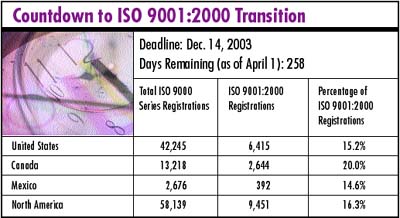 New Groups Consider ISO Auditing Practices
New Groups Consider ISO Auditing Practices
The International Accreditation Forum, ISO/TC 176 and CASCO
have formed the ISO 9001 Advisory Group, a mutually representative
group to consider the credibility of ISO 9001 and its certification.
Under the guidance of IAF, the IAG is responsible for:
Monitoring the credibility of ISO 9001 for certification
and providing feedback to each of the component members
of the group
 Providing a forum for discussion of user satisfaction and
creating action plans when complaints or indications of
concern are identified
Providing a forum for discussion of user satisfaction and
creating action plans when complaints or indications of
concern are identified
 Identifying issues that indicate the need for official ISO/TC
176 interpretations to ISO 9001:2000 or specific IAF guidance
Identifying issues that indicate the need for official ISO/TC
176 interpretations to ISO 9001:2000 or specific IAF guidance
 Providing feedback to ISO/TC 176 on the acceptance of its
standards and providing input for future revisions
Providing feedback to ISO/TC 176 on the acceptance of its
standards and providing input for future revisions
 Acting as a basis for "shadow" committees on a
local or regional basis for ISO member bodies and accreditation
body members of IAF.
Acting as a basis for "shadow" committees on a
local or regional basis for ISO member bodies and accreditation
body members of IAF.
ISO/TC 176 is the committee responsible for forming the
ISO 9001 quality management system, and CASCO is the ISO
Committee on conformity assessment.
During a September meeting, the IAG identified a lack
of understanding of the process approach to auditing. ISO/TC
176 is currently initiating a revision of the Guidance on
the Process Approach, and the IAG has plans to develop specific
guidance on best practices for auditing to the new standard.
The IAG met in February to discuss actual and potential
threats to the credibility of ISO 9001. During the meeting,
the group reviewed the factors affecting ISO 9001 credibility,
compiled relevant initiatives by members of the IAG, performed
a gap analysis to identify problems not currently addressed
by IAF members, and assessed the progress of transition
to the new standard.
Additionally, IAF agreed to formalize the group's composition
to ensure a balance of interests from industry, accreditation
and certification bodies, auditing practitioners, ISO/TC
176, and CASCO.
The first meeting of the Good Auditing Practice group
also took place in February. GAP discussed the development
of practical guidelines on effective means of auditing against
ISO 9001:2000 for third-party registrars. These guidelines
will be compiled into a "how to" document with
practical examples, forms and other tools that address past
poor practices and recommended good practices.
The activities of IAG and GAP will parallel work already
underway by the IAF to encourage a competence-based approach
to accreditation audits. The overall direction for both
groups is toward maximizing the effectiveness of results-based
auditing.
The IAF is a global association of conformity assessment
accreditation bodies and other bodies interested in conformity
assessment. To learn more, visit www.iaf.nu.
IAF's Relationship with ISO
The International Accreditation Forum works in liaison
with the following four ISO technical committees:
 ISO/TC 176--Scope includes standardization of generic quality
management systems and supporting technologies, and specific
standardization at the request of affected sectors.
ISO/TC 176--Scope includes standardization of generic quality
management systems and supporting technologies, and specific
standardization at the request of affected sectors.
 ISO/TC 176/SC 2--A subcommittee of ISO/TC 176. The group
is directly responsible for 10 ISO standards.
ISO/TC 176/SC 2--A subcommittee of ISO/TC 176. The group
is directly responsible for 10 ISO standards.
 ISO/TC 207--Responsible for standardization of environmental
tools and management systems.
ISO/TC 207--Responsible for standardization of environmental
tools and management systems.
 CASCO--The ISO Committee on conformity assessment. CASCO's
responsibilities include studying the conformity assessment
of products, processes, services and management systems
to standards or other technical specifications; preparing
international guidelines and standards relating to testing,
inspection and certification of products, processes, and
services; assessing management systems, testing laboratories,
inspection bodies, certification bodies, accreditation bodies
and their operations; and other duties.
CASCO--The ISO Committee on conformity assessment. CASCO's
responsibilities include studying the conformity assessment
of products, processes, services and management systems
to standards or other technical specifications; preparing
international guidelines and standards relating to testing,
inspection and certification of products, processes, and
services; assessing management systems, testing laboratories,
inspection bodies, certification bodies, accreditation bodies
and their operations; and other duties.
Study Reveals Need for Vision Technology
Standards
The machine vision industry generated revenues of $1.12
billion in 2002 and estimates revenues of up to $2.62 billion
by 2009, according to a recent study conducted by the consulting
group Frost & Sullivan.
"World Machine Vision Inspection System Markets"
contends that because of this estimated growth, a common
standard for machine vision technology is needed. Experts
at Frost cite two major reasons to develop a common standard:
increasing system component capability options and making
systems more appealing to end-users.
"The lack of operating standards within the machine
vision industry creates difficulties in developing and operating
vision systems, and end-users often can't connect desired
components," explains Sunderraju Ramachandran, research
analyst at Frost & Sullivan. "Conflicts between
components, computer software and hardware technologies
and user interfaces reduce credibility for the industry
as a whole because there is no plug-and-play for generic
systems."
End-users want systems that contain more robust technology,
have greater potential applications and add value, the document
states. Also in demand are simpler user interfaces to allow
comfortable interaction with the system, regardless of the
level of technical knowledge. Other areas that need focus
include optical character- and pattern-recognition algorithms,
resolution and image mapping.
A major hurdle for machine vision technology is increasing
buyer awareness of the capabilities of vision systems and
eliminating consumer skepticism created by earlier, less
capable systems.
The study is organized by industry: automotive, electronics,
semiconductor, food, pharmaceutical and world vision systems
markets. Each section contains an overview of the state
of machine vision technology within that market, along with
revenue forecasts, demand analyses, market and technology
trends, and pricing trends.
Frost & Sullivan provides strategic growth consulting
and market analysis. To obtain a copy of "World Machine
Vision Inspection System Markets," call (877) 463-7678
or visit www.testandmeasurement.frost.com.
Countdown to ISO 9001:2000 Transition


Six Sigma Success for Staffing Services
By now, anyone even remotely interested in quality knows
that Six Sigma is the hottest defect-reducing tool out there.
Beginning with Motorola, the methodology has worked its
way through a host of industries, namely manufacturing and
service organizations.
As Six Sigma steadily penetrates U.S. organizations, many
are hesitant to begin the implementation process, thinking
that Six Sigma doesn't apply to them. Many organizations
assume that Six Sigma won't work because it has never before
been implemented in their industry. Other organizations,
such as Volt Services Group, are proving them wrong.
Volt Services Group, the staffing business unit of Volt
Information Sciences Inc., has announced that it is the
first leading staffing company to implement Six Sigma.
"Volt uses Six Sigma to consistently quantify and
track process improvements, maximize employee productivity,
improve service delivery, enhance our organizational focus
and efficiency, and accelerate the adoption of new staffing
technologies," explains Jerome Shaw, executive vice
president and co-founder of Volt Information Sciences. "Many
of our top customers are Six Sigma companies as well. Six
Sigma will give us the tools we need to align Volt's service
strategies to our customers' workforce objectives."
Volt's Six Sigma initiative began in August 2002 with
the appointment of Excelsis Magno, a certified Master Black
Belt, to the position of director of business process improvement.
Magno is responsible for executing Volt's Six Sigma strategy,
developing necessary tools and overseeing the implementation
of the initiative.
So far, Volt has reached several milestones, including
the formation and training of its senior executive leadership
council for Six Sigma, communication of the Six Sigma mission
to its more than 31,000 employees, and the identification
and acceptance of key projects.
Volt is also deploying and training individuals within
its organization as Black Belts, selected among the company's
highest performing employees.
Volt's staffing services segment fulfills information
technology and other technical, commercial and industrial
placement requirements on both a temporary and permanent
basis. For more information, visit www.volt.com.

ISO Considers Creating Social Responsibility
Standard
An advisory panel has recommended to the International
Organization for Standardization that it should consider
developing standards that address the social responsibility
of organizations.
To determine whether ISO should pursue creating social
responsibility standards, the advisory group recommended
that the organization develop a technical report surveying
the worldwide state of social responsibility codes, guidelines
and specifications. In addition, the group advocated a justification
study to prepare a management system guideline standard
that specifically includes a process for the self-declaration
of conformity and excludes conformity assessment involving
third-party certification.
The advisory panel is headed by Daniel Gagnier, chairman
of ISO/TC 207, the technical committee responsible for the
ISO 14000 series of standards. The panel comprises representatives
from various stakeholders, including businesses, government
regulators, trade unions and consumers. The provisional
working definition of social responsibility used by the
panel is "a balanced approach for organizations to
address economic, social and environmental issues in a way
that aims to benefit people, communities and society."
The recommendations were developed from the advisory group's
February meeting in Geneva and were reviewed by the ISO
council in March. The technical management board initially
convened the advisory group to examine whether standardization
would add value to already existing corporate social responsibility
programs.
Currently, Social Accountability International's SA8000
guidelines are broadly recognized as one of the strongest
social responsibility standards. Based on International
Labor Organization conventions and the United Nation's Declaration
of Human Rights and the U.N. Convention on Rights of the
Child, the standard covers nine issues related to social
responsibility: child labor, forced labor, health and safety,
freedom of association and the right to collective bargaining,
discrimination, discipline, working hours, compensation,
and management systems.
To learn more about ISO's actions toward a social responsibility
standard, visit www.iso.org.
For information about SA8000, visit www.cepaa.org.
 Financial
Organization Implements Six Sigma Alternative Financial
Organization Implements Six Sigma Alternative
Organizations have several options when choosing a quality
initiative: Six Sigma, ISO 9001, lean manufacturing, 5S,
quality circles, total quality management, kaizen…
the list could possibly fill this page. Perhaps the reason
there are so many quality improvement strategies is that
no one organization is exactly like another. And when companies
find that these prepackaged quality "shoes" simply
don't fit, many fashion their own using elements of existing
methods.
One such company is Countrywide Financial Corp., which
has developed and implemented FASTER, a proprietary project
management methodology modeled after Six Sigma. The company
asserts that FASTER is more accessible and applicable to
a financial services environment
FASTER is an acronym for the six steps in the life cycle
of a project: flow, analyze, solve, target, execute and
review.
"We anticipate Countrywide will, over time, realize
dramatic positive returns on our investment in FASTER,"
says Stanford L. Kurland, CEO. "Already, more than
500 projects have either been completed or are currently
underway."
The initiative provides tools for flowcharting, financial
analysis, structured meetings and management reports. It
has been adopted as the company standard to create a consistent
project management approach and a common language for employees
throughout the company.
Countrywide began its quality overhaul in January 2001,
when the company created its Performance Management Group
to spearhead strategic initiatives and formalize the company's
continuous improvement culture. The group developed the
FASTER methodology and trained employees on its application.
To learn more, visit www.countrywide.com.
|